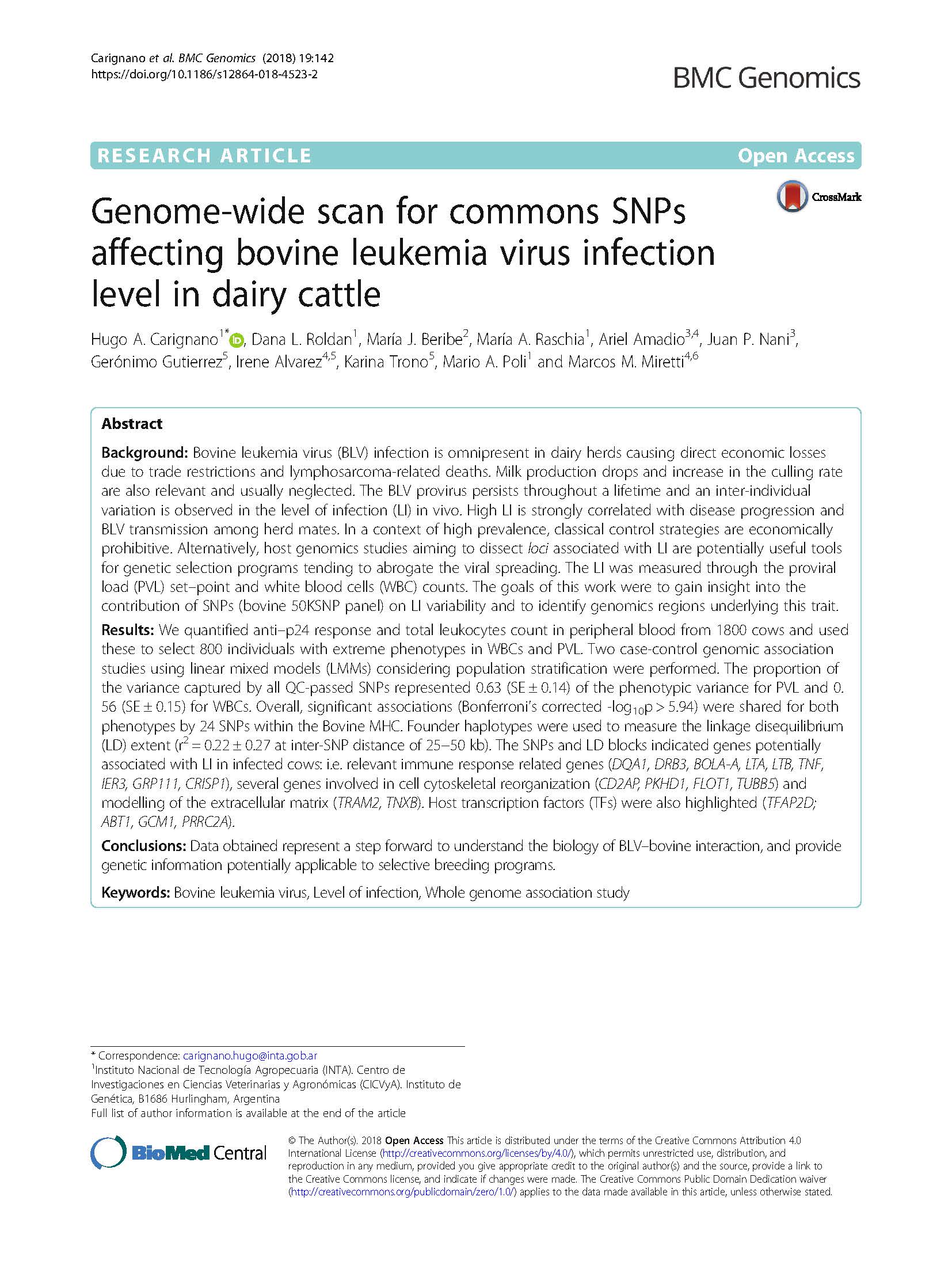Ver ítem
- xmlui.general.dspace_homeCentros e Institutos de InvestigaciónCICVyA. Centro de Investigación en Ciencias Veterinarias y AgronómicasInstituto de GenéticaArtículos científicosxmlui.ArtifactBrowser.ItemViewer.trail
- Inicio
- Centros e Institutos de Investigación
- CICVyA. Centro de Investigación en Ciencias Veterinarias y Agronómicas
- Instituto de Genética
- Artículos científicos
- Ver ítem
Genome-wide scan for commons SNPs affecting bovine leukemia virus infection level in dairy cattle
Resumen
Background: Bovine leukemia virus (BLV) infection is omnipresent in dairy herds causing direct economic losses
due to trade restrictions and lymphosarcoma-related deaths. Milk production drops and increase in the culling rate
are also relevant and usually neglected. The BLV provirus persists throughout a lifetime and an inter-individual
variation is observed in the level of infection (LI) in vivo. High LI is strongly correlated with disease progression
[ver mas...]
Background: Bovine leukemia virus (BLV) infection is omnipresent in dairy herds causing direct economic losses
due to trade restrictions and lymphosarcoma-related deaths. Milk production drops and increase in the culling rate
are also relevant and usually neglected. The BLV provirus persists throughout a lifetime and an inter-individual
variation is observed in the level of infection (LI) in vivo. High LI is strongly correlated with disease progression and
BLV transmission among herd mates. In a context of high prevalence, classical control strategies are economically
prohibitive. Alternatively, host genomics studies aiming to dissect loci associated with LI are potentially useful tools
for genetic selection programs tending to abrogate the viral spreading. The LI was measured through the proviral
load (PVL) set–point and white blood cells (WBC) counts. The goals of this work were to gain insight into the
contribution of SNPs (bovine 50KSNP panel) on LI variability and to identify genomics regions underlying this trait.
Results: We quantified anti–p24 response and total leukocytes count in peripheral blood from 1800 cows and used
these to select 800 individuals with extreme phenotypes in WBCs and PVL. Two case-control genomic association
studies using linear mixed models (LMMs) considering population stratification were performed. The proportion of
the variance captured by all QC-passed SNPs represented 0.63 (SE ± 0.14) of the phenotypic variance for PVL and 0.
56 (SE ± 0.15) for WBCs. Overall, significant associations (Bonferroni’s corrected -log10p > 5.94) were shared for both
phenotypes by 24 SNPs within the Bovine MHC. Founder haplotypes were used to measure the linkage disequilibrium
(LD) extent (r2 = 0.22 ± 0.27 at inter-SNP distance of 25−50 kb). The SNPs and LD blocks indicated genes potentially
associated with LI in infected cows: i.e. relevant immune response related genes (DQA1, DRB3, BOLA-A, LTA, LTB, TNF,
IER3, GRP111, CRISP1), several genes involved in cell cytoskeletal reorganization (CD2AP, PKHD1, FLOT1, TUBB5) and
modelling of the extracellular matrix (TRAM2, TNXB). Host transcription factors (TFs) were also highlighted (TFAP2D;
ABT1, GCM1, PRRC2A).
Conclusions: Data obtained represent a step forward to understand the biology of BLV–bovine interaction, and provide
genetic information potentially applicable to selective breeding programs
[Cerrar]

Fuente
BMC Genomics 19 :142. (2018)
Fecha
2018-02-13
ISSN
1471-2164
Formato
pdf
Tipo de documento
artículo
Palabras Claves
Derechos de acceso
Abierto
 Excepto donde se diga explicitamente, este item se publica bajo la siguiente descripción: Creative Commons Attribution-NonCommercial-ShareAlike 2.5 Unported (CC BY-NC-SA 2.5)
Excepto donde se diga explicitamente, este item se publica bajo la siguiente descripción: Creative Commons Attribution-NonCommercial-ShareAlike 2.5 Unported (CC BY-NC-SA 2.5)


